Brittany Maynard’s “Death With Dignity”

29-year old Brittany Maynard was living on borrowed breath. She was told that the days that stretched out before her were going to be few and fraught with debilitating illness and agony.
On New Year’s Day of this year, just fifteen months after her wedding, Brittany was diagnosed with stage IV terminal brain cancer. With no hope in her heart for a cure, only a plan for dying on her own terms, she placed a lethal dose of pills upon her tongue and chose which remaining breaths would be her last.
On Saturday, surrounded by her most-loved ones, she said goodbye and went to sleep never to awaken again.
What should have been a first year of marriage filled with hope and dreams for the future became a nightmare from which she could only have wished to somehow awaken.
Instead of being able to realize their newlywed dreams of building tomorrows, they found themselves researching ways to either extend the days Brittany had remaining or….not. Brittany chose to “die with dignity.”
Brittany made her plight an international story through advocating for end of life organizations such as Compassion & Choices, a nonprofit organization “committed to helping everyone have the best death possible.” She became a household name when she announced that she had chosen November 1, 2014 as her death day to spare herself and her family from the final stages of her terminal brain cancer.
The news was met with predictable compassion for her circumstance mixed with either repugnance or respect. Videos were released capturing some of her journey as her cancer progressed with testimony of her whys and hows to ensure that her story somehow lends courage to others who find themselves in her sad shoes one day.
The phrase, “die with dignity,” solicits passionately-charged reactions that span the spectrum of belief systems. The very idea elicits deeply-held judgments regardless of personal experience with one’s own looming death or the death of a loved one.
 Brittany and her husband, Dan Diaz, along with a few family members, moved to Oregon from their home in California to be able to end her life on her terms through the provisions of the Oregon Death With Dignity Act. Washington, Montana, Vermont and New Mexico are the only other states where “aid-in-dying,” otherwise known as “assisted suicide,” is legal.
Brittany and her husband, Dan Diaz, along with a few family members, moved to Oregon from their home in California to be able to end her life on her terms through the provisions of the Oregon Death With Dignity Act. Washington, Montana, Vermont and New Mexico are the only other states where “aid-in-dying,” otherwise known as “assisted suicide,” is legal.
Advocates for “aid-in-dying” maintain that every individual has the right and should be given the option to decide how and when their lives should end should they be faced with a terminal illness. They seek to campaign for greater national access to end-of-life medical assistance for terminally ill, mentally competent adults who request medication to shortcut their dying process.
Organizations like Compassion & Choices stated efforts seek to increase patient control over unwanted medical interventions at the end of life; pass more legislation to further the aid-in-dying movement; normalize end of life language using “aid-in-dying” over the more common “assisted suicide”; and expand the end of life choice movement.
Words like “brave” and “courageous” are attributed to the ones who choose to die by their own hand instead of allowing the natural, though often horridly brutal, course of life to extinguish itself.
Opponents of aid-in-dying believe that taking one’s own life is suicide (defined as the intentional act of taking of one’s own life). Whether it is rooted in a faith-based belief or a natural, moral vein, many people cringe at the very idea of pulling that proverbial trigger.
The decision is too bold, too final and conjures up unsettling questions about the here-after.
Throughout Brittany’s public demise, social media hosted frenzied discourse from those who’ve suffered the natural ravages of disease either personally or in a loved one’s wake.
Gut-wrenching testimony continues to pour in from people who’ve arrived on the “other side” of ravaging disease, near-death or eventual death of loved ones to proclaim that even in the trenches of wasting disease and pain, life is precious and worth living until the last breath is naturally drawn.
They jealously guard the use of descriptors such as “brave” and “courageous” for those who traversed naturally through life’s end.
Many people of Christian faith, for instance, passionately conclude that God who granted them life, also delivers them through the dying process, whatever that may hold. To them, all life is sacred whether sublime or sad; robust or rickety; well or weak.
Many Christians believe that life on earth is but a pass-through to an eternal destination where there isn’t even time that marks a life-span, nor is there any more sadness, sickness, pain or death. There is judgment for the life lived and choices made while among the living…..
Brittany Maynard ended her life last Saturday.
She’s gone but her chilling story will live on, fueling heated debates over end-of-life issues for years to come.
Faced with the future in light of the knowledge that her moments remaining would be few and filled with suffering, she laid down in her family bed in her little yellow house in the embrace of those she loved the most. After ingesting the poison pills, Brittany drew her final breaths.
The reality is that there isn’t anyone alive today who isn’t living on borrowed breath. We live. We die. Brittany wasn’t the first to face a terminal diagnosis and she won’t be the last.
The questions remain: Can you take your own life if faced with a terminal illness? Apparently, yes, if you live in, or move to, the right state.
As a culture and individually, the deeper and more cutting questions remain as unsettling as they were last Friday: Would you?; Could you?; Should you?
